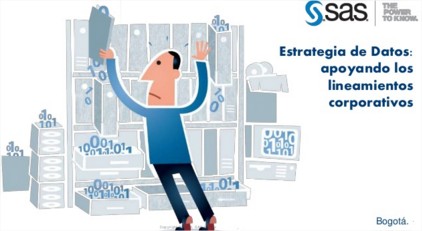
.@philsimon provides insights on whether a data strategy can result in competitive advantage.

.@philsimon provides insights on whether a data strategy can result in competitive advantage.

In Part 1 of this series, Cheryl Doninger described how SAS Grid Manager can extend your investment in the Hadoop infrastructure. In this post, we’ll take a look at how Cloudera Manager helps Hadoop administrators meet competing service level agreements (SLAs). Cloudera Manager lets Hadoop admins set up queues to

Si se ha preguntado ¿los datos de la organización pueden contribuir al desarrollo de los lineamientos corporativos? La respuesta es sí: implementando una estrategia de Data Management. Para desarrollar y ejecutar una eficiente estrategia de Datos que esté alineada a sus objetivos de negocio, lo invitamos a seguir las siguientes recomendaciones:
.@philsimon on the need to play offense and defense with your organization's data.

It’s hard to believe that another year is over. 2015 is behind us; 2016 is ahead. As I looked back over this year, I recalled starting last year at the National Retail Federation Big Show. I presented in the SAS booth on “Optimizing Pricing Decisions.” The presentation was simple and used the concept of

In this two-part series, which posts as the calendar turns to a new year, I revisit the top data management topics of 2015 (Part 1) and then try to predict a few of the data management trends of 2016 (Part 2). Data management in 2016 The Internet of Things (IoT) made significant

In this two-part series, which posts as the calendar prepares to turn 2015 into 2016, I revisit the top data management topics of 2015 (Part 1) and then try to predict a few of the data management trends of 2016 (Part 2). Data management in 2015 Big data continued to make

In two previous posts (Part 1 and Part 2), I explored some of the challenges of managing data beyond enterprise boundaries. These posts focused on issues around managing and governing extra-enterprise data. Let’s focus a bit on one specific challenge now – satisfying the need for business users to rapidly ingest new data sources. Sophisticated business
PharmaVOICE recently published an article: Analytics Driven Marketing for the pharmaceutical industry and I was fortunate enough to be interviewed. The article discusses the increased use of advanced analytics to make better marketing decisions, the progress that has been made and the challenges that still need to be overcome. Within

PharmaVOICE recently published an article: Analytics Driven Marketing for the pharmaceutical industry and I was fortunate enough to be interviewed. The article discusses the increased use of advanced analytics to make better marketing decisions, the progress that has been made and the challenges that still need to be overcome. Within

Most people have logged on to a social media site, maybe to look up an old friend, acquaintance or family member. Some people play games, or post funny pictures or other information they want to share with everyone. Do you ever ask yourself what happens with this information? What if your business wanted to purchase this information and

In 2014, big data was on everyone’s mind. So in 2015, I expected to see data quality initiatives make a major shift toward big data. But I was surprised by a completely new requirement for data quality, which proves that the world is not all about big data – not

Sometimes when trying to fuzzy match names you want to fuzzy match just a portion of the name: for example, Family Name and/or Given Name. A common mistake that people make is to feed in the Family Name and Given Name columns separately into the Match Codes node instead of

Bube, Dame, König, Ass oder die vier unterschiedlichen Arten von Anwendern die man in Datenmanagementprojekten überzeugen muss. Bube, Dame, König, Ass - Man könnte auch pokern (Excel reicht nicht).

Twenty-five years ago (when I was 12 years old), we realized that data, across the corporation, was not integrated. Nor did our data let us predict the future by looking at the past. So we started creating these stores of historical data soon to be called “data warehouse.” Here are

Confusion is one of the big challenges companies experience when defining the data governance function – particularly among the technical community. I recently came across a profile on LinkedIn for a senior data governance practitioner at an insurance firm. His profile typified this challenge. He cited his duties as: Responsible for the collection
Modernization. It’s a hot topic for organizations in all types of industries that are looking for ways to streamline hardware and software footprints while gaining control and insights from the data deluge. In the data integration space, this means we have to look beyond a traditional ETL approach to one

Time. It flies. It does so whether or not you’re having fun or otherwise putting it to good use. To know where it flies, you’d need to watch. But most of us can’t make the time to watch. How we use time is important since it’s the one resource we

Das Christkind ist ausgesprochen zufrieden mit sich und seinen Vorbereitungen. Wir möchten vermuten, dass dem Christkind die Komplexität seiner Aufgabe (trotz zweitausendjähriger Geschichte) erst jetzt so richtig dämmert. Es hat gelernt, assoziativ zu suchen, Kommentare der Kinder zu analysieren und aus allem die richtigen Schlüsse zu ziehen. Heute verfeinert es

In my first post, I talked about the hell of using Excel for all your data needs; in my second post, I covered the building blocks and initial first steps that will lead you to a future proof data strategy. Now let’s zoom in on the three domains that underpin

There is no doubt about it – over the past few years there has been a monumental shift in how we think about “enterprise” data management. I believe this shift has been motivated by four factors: Open data. What may have been triggered by demands for governmental transparency and the need

In my previous post, I discussed some of the challenges and costs organizations face when they’re stuck in Excel hell with no real data strategy. Now that we’ve discussed the problem, let’s dive into the solution. Every organization needs a data strategy with these building blocks: Your top priority is

Learn the top 5 reasons for managing data where it lives – whether it's in database or in memory, in the cloud or in-stream.

To prepare for the data challenges of 2015 and beyond, health care fraud, waste and abuse investigative units (government funded and commercial insurance plans, alike) need a data management infrastructure that provides access to data across programs, products and channels. This goes well beyond sorting and filtering small sets of

This summer, I had several interesting sessions with customers and prospects. Much to my surprise, two of them, both multinational organizations, were doing most of their data related tasks in Excel. This happens every now and then -- I come across organizations (like yours?) where people are manipulating and ‘analysing’

I feel like I'm singing a song called Data in the Sky – With Options! The cloud is forever in our minds these days as a lower cost option because it requires fewer resources to address our data needs. Cloud solutions are an increasing part of many organizations' budgets every year. Whether enterprise data is

The phrase “business rules” is often loosely used. It can refer to things like constraints in a query, a data mapping, a data quality constraint, a data transformation, or a model. Business rules also reflect an enforced policy, a regulatory requirement and business constraints on model scores that trigger analytically-driven

Working on a data migration project gives you a unique opportunity to learn where your organization has fallen short in its data management strategy. It's when you start to explore your legacy data landscape that you get a feel for how big a silo challenge your company has. It wasn't

Many people perceive big data management technologies as a “cure-all” for their analytics needs. But I would be surprised if any organization that has invested in developing a conventional data warehouse – even on a small scale – would completely rip that data warehouse out and immediately replace it with an NoSQL

Is your LASR implementation running short on memory? Since LASR tables are stored in memory, it can become scarce. So what can we do to minimize LASR table size and still get LASR’s legendary performance? Here are a few strategies on how to shrink LASR tables: Compression: When compression was